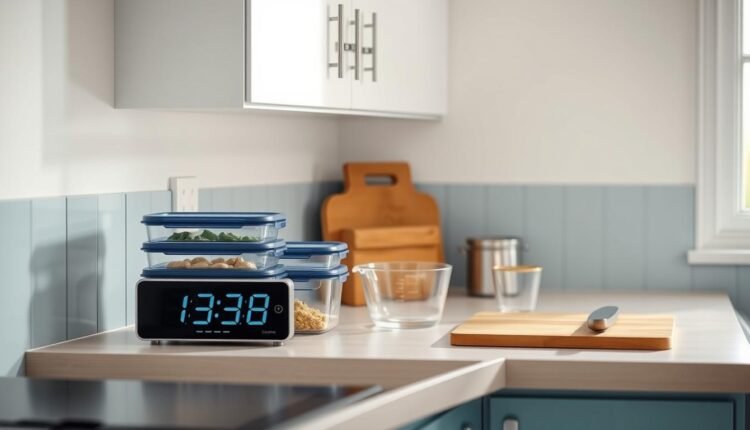Lunch Meal Prep One Hour System For Busy Weeks
Transform your lunches with our lunch meal prep one hour system. Get ready for a stress-free week with our practical guide
As an Asheville chef and mom of two, I’ve seen how chaotic weekdays can get. That’s why I designed a streamlined approach to cooking that balances flavor and efficiency—no culinary degree required. This method isn’t about fancy techniques; it’s about working smarter with sheet pans, smart seasoning blends, and strategic multitasking.
You’ll discover how roasted garlic chicken, crispy potatoes, and vibrant veggies come together while your rice cooker handles the carbs. The secret? Layering textures and bold flavors (think smoked paprika or lemon zest) so you actually want to eat what’s in those containers. I’ve even included swaps for dietary needs—swap cauliflower rice or sweet potatoes if that’s your jam.
Here’s what makes this system work:
- Batch cooking proteins and grains simultaneously
- Using versatile sauces to prevent flavor burnout
- Storing components separately for mix-and-match flexibility
Planning and Preparation for a Stress-Free Week
Let me share a lesson from my busiest parenting days: good meals begin with great planning. A well-organized kitchen starts with smart ingredient selection and tool preparation—two steps that transform chaotic cooking into smooth execution.
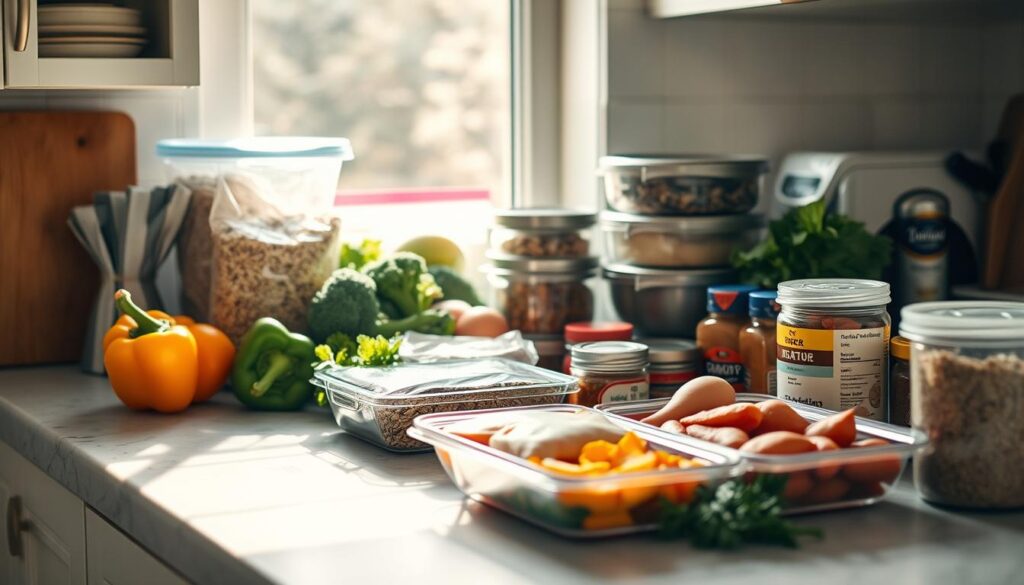
Grocery List Strategy That Works
Start by choosing 3-4 base recipes sharing common ingredients. For example, roasted chicken with garlic powder works in tacos, salads, and grain bowls. This approach reduces waste and ensures you buy only what you need. I always include:
- Proteins like chicken thighs (more forgiving than breasts)
- Sturdy veggies: potatoes, sweet potatoes, broccoli
- Flavor boosters: minced garlic, olive oil, smoked paprika
Tool Setup for Maximum Efficiency
Clear counter space and gather essentials before cooking. My must-haves include:
- Two sheet pans for roasting veggies and proteins together
- Glass containers with compartments to keep items fresh
- A quality knife and cutting board for quick prep work
Don’t shy away from pre-cut veggies or jarred minced garlic—these time-saving swaps let you focus on flavor building. Last week, I used pre-spiralized sweet potatoes to shave 15 minutes off my prep time!
Pro tip: Store raw proteins separately from cooked grains. This prevents sogginess and lets you create new combinations like lemon-pepper chicken over rice or spicy cauliflower bowls later in the week.
Essential Techniques to Achieve a Quick Meal Prep
The secret to stress-free cooking? Let your appliances do the heavy lifting. I’ve found that mastering oven logistics and strategic prep turns chaotic kitchens into calm spaces where flavors shine.
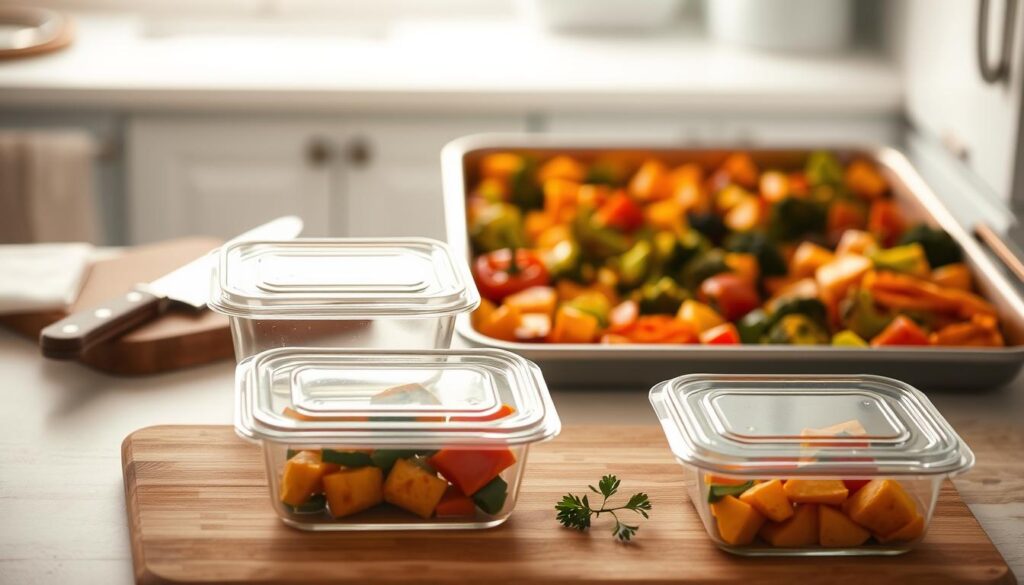
Utilizing Sheet Pan Magic and Oven Timers
Start by preheating your oven to 425°F—the sweet spot for crispy textures. Arrange chicken breasts on one half of a sheet pan, tossing broccoli and Brussels sprouts with olive oil on the other. This method cooks proteins and veggies simultaneously while preserving distinct flavors.
“Always place denser veggies like potatoes on lower oven racks—they need more direct heat than delicate proteins.”
Set two timers: one for proteins (20-25 minutes) and another for veggies (15-18 minutes). For salmon, reduce heat to 400°F and cook skin-side down for 12-14 minutes. This precision prevents overcooking.
Efficient Cooking Methods for Proteins and Veggies
While your sheet pan works, start rice in a cooker or quinoa on the stovetop. Season simply: garlic powder and smoked paprika create depth without complexity. See the table below for perfect pairings:
| Protein | Temp | Time | Veggie Pairing |
|---|---|---|---|
| Chicken breasts | 425°F | 22 min | Broccoli + bell peppers |
| Salmon filets | 400°F | 14 min | Zucchini + cherry tomatoes |
Store components separately in glass containers with compartments to maintain textures. This system lets you mix roasted garlic chicken with quinoa or flake salmon over greens—all while keeping cleanup under 10 minutes.
Effective Strategies for lunch meal prep one hour
Between soccer practices and work deadlines, I’ve learned that successful kitchen sessions hinge on two things: strategic timing and smart storage. Here’s how to transform chaotic cooking into a well-oiled routine.
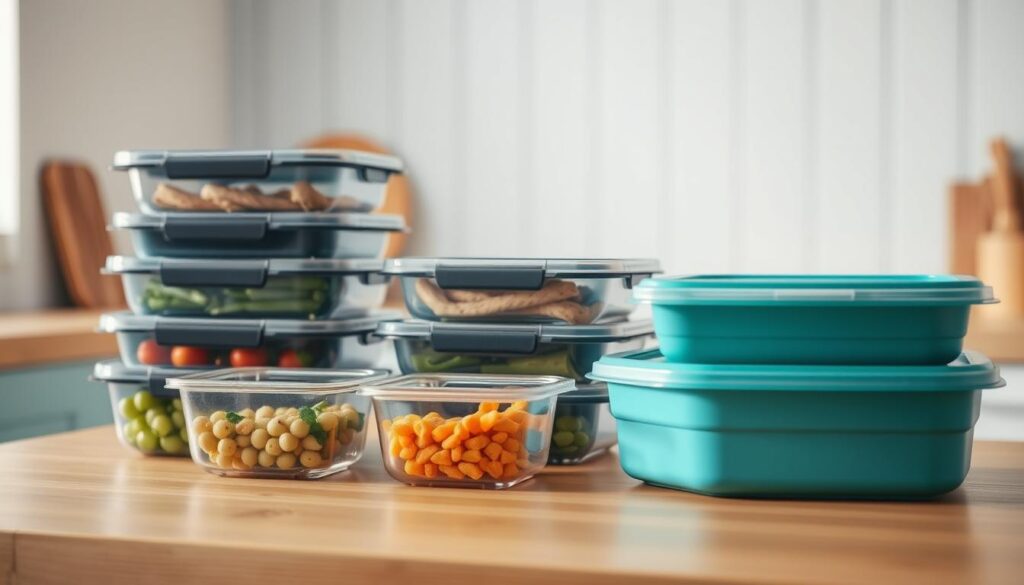
Time Management and Multitasking in the Kitchen
Start your session by firing up the rice cooker—grains take the longest. While they simmer, season proteins with garlic powder and olive oil. As Chef Callie Renner advises: “Layer tasks like you’re conducting an orchestra—roast veggies while chicken bakes, steam broccoli as quinoa cools.”
- Set multiple timers (phone alarms work) for staggered cooking stages
- Chop next-day veggies while sheet pans roast current items
- Cool hot components on baking racks before refrigerating
Streamlining Cooking Processes and Container Setup
Glass containers with compartments are worth their weight in gold. I organize mine like a painter’s palette—proteins here, roasted garlic there, sauces on the side. This system lets my family build bowls without reheating everything.
| Container Type | Best For | Fridge Lifespan |
|---|---|---|
| 3-compartment glass | Complete meals | 4 days |
| Single-section stainless | Sauces/dressings | 7 days |
Pro tip from All Recipes: Store containers vertically in the fridge using file organizers. This “flat library” system prevents forgotten leftovers and keeps textures crisp.
Maximizing Flavor and Variety in Your Meal Prep
Ever stare at your fridge and think, “Did I make the same dish five days straight?” I’ve cracked the code to keeping taste buds excited—it’s all about strategic tweaks. My kitchen mantra: “Master the base, then play with pace.”
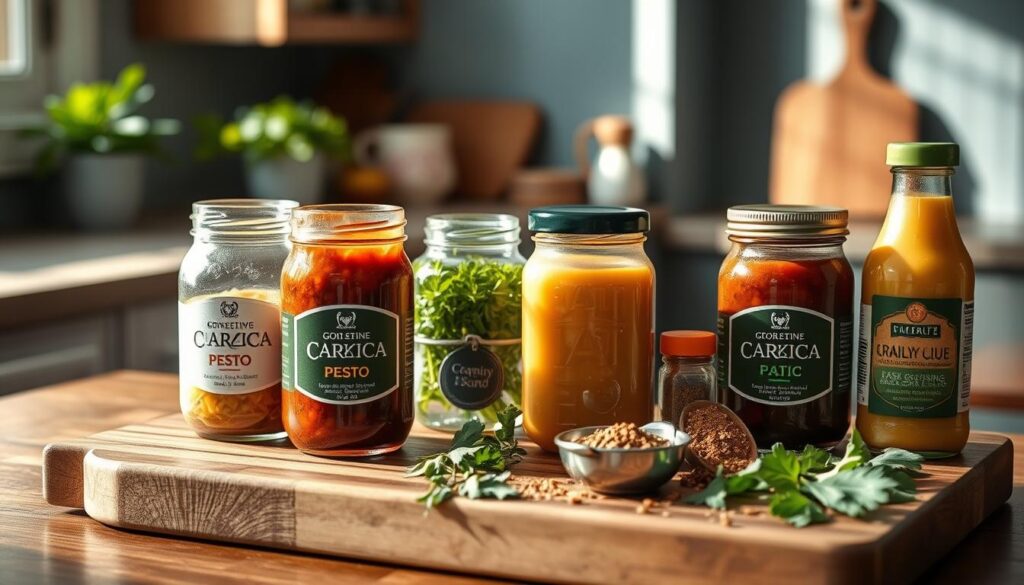
Your Flavor Toolkit: Sauces & Swaps
Store-bought salsa transformed my roasted chicken last week. A dollop on day three made it feel like a new creation. Keep these heroes handy:
- Global sauces: gochujang (Korean chili), pesto, or tahini
- Dry rubs: garlic powder + smoked paprika for smoky depth
- Fresh accents: lemon zest, chopped herbs, or pickled veggies
Swap starchy sides weekly. Roasted sweet potatoes (tossed in olive oil and pepper) beat regular potatoes for variety. Try this pairing guide:
| Base Protein | Carb Swap | Top With |
|---|---|---|
| Lemon chicken | Quinoa | Pesto + cherry tomatoes |
| Seared tofu | Red baby potatoes | Kimchi + sesame seeds |
Pro tip: Roast spices like cumin or coriander for 2 minutes before grinding. This trick from my failed “bland bowl” phase adds restaurant-worthy depth. Store components separately—toss greens with dressing day-of for crunch.
Your turn: Which combo will you try first? A spicy gochujang drizzle? Smoky sweet potatoes? Remember, even one bold change keeps things fresh all week.
Picture this: A fridge stocked with vibrant, ready-to-enjoy dishes that actually excite you every afternoon. With smart planning and strategic cooking, this becomes your reality. Start by mapping recipes sharing core ingredients—garlic powder-roasted chicken works in tacos, salads, or grain bowls. Layer tasks like roasting broccoli on sheet pans while grains cook.
Store components in glass containers to preserve textures. Olive oil-tossed potatoes stay crisp beside seasoned proteins. Need variety? Swap sauces daily—a drizzle of pesto or sprinkle of smoked paprika reinvents leftovers. This system thrives on simplicity: salt and pepper basics become bold flavors through smart pairings.
Busy families and professionals alike benefit from this approach. Carbs like quinoa or sweet potatoes fuel busy days without monotony. Pro tip: Label containers with dates and recipe ideas to spark creativity midweek.
Ready to reclaim your kitchen rhythm? Share your top flavor combos using #PrepistryWins. Let’s build a community of inspired cooks—one perfectly seasoned sheet pan at a time.
Sheet Pan Za’atar Chicken with Carrot-Cauliflower Couscous
A vibrant and aromatic sheet pan dinner featuring za’atar-seasoned chicken thighs roasted alongside a medley of carrots and cauliflower, served over fluffy couscous for a wholesome Middle Eastern-inspired meal.

Nutrition Information
Equipment Needed
- Sheet pan
- Mixing bowls
- Chef's knife
- Cutting board
- Measuring spoons
- Measuring cups
- Aluminum foil
- Large spoon
Ingredients
-
4 bone-in, skin-on chicken thighs
-
2 tablespoons za’atar spice blend
-
3 tablespoons olive oil, divided
-
1 tablespoon lemon juice
-
2 carrots, peeled and sliced
-
1 small head cauliflower, cut into florets
-
1 cup couscous
-
1 1/4 cups chicken broth
-
1/4 cup chopped fresh parsley
-
Salt and pepper to taste
Instructions
Recipe Video
Sheet Pan Za’atar Chicken with Carrot-Cauliflower Couscous
Learn how to prepare a flavorful and easy sheet pan dinner featuring za’atar-seasoned chicken thighs roasted with carrots and cauliflower, served over couscous.

